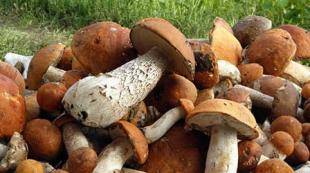Stud driver: simple work with complex fasteners. Stud drivers and options for twisting studs without them How to unscrew a stuck stud
In the practice of repairing automotive equipment, it becomes necessary to screw in and out of studs - fasteners without turnkey surfaces. For these purposes, a special tool is used - a stud driver or a key for studs. Read about stud drivers, their types, work and choice in this article.
What is a hairpin?
A stud driver (key for studs) is a specialized tool for screwing in and out of threaded studs.
Stud - a fastener in the form of a rod with a thread at both ends. The stud is screwed into the product with one part, and the nut is screwed onto its second part. The design of the stud does not provide for special surfaces for thorns (such as heads for bolts or edges for nuts) or other tools, which greatly complicates the procedure for screwing in and out. As a result, it is necessary to use special tools, which are called stud wrenches or simply stud drivers.
For the correct purchase of a stud driver, it is necessary to understand the existing types of this tool, their features and advantages.
Types, design and principle of operation of the stud driver
The main problem of working with studs is to ensure reliable fixation of the cylindrical rod without damaging it and with the force necessary for screwing in or out. Several solutions to this problem have been proposed, and according to the method of clamping the studs, the stud drivers are divided into several types:
- roller;
- Eccentric;
- Collet (cam);
- With nut clamp and stop.
In this case, all types of tools can have the execution of one of two types:
- An independent tool that works without additional devices;
- Equipment for working with conventional wrenches, wrenches, ratchets and other devices.
The tool of the first type is convenient and easy to use, it is always ready for use, however, as a rule, it has a more complex design and high cost. The second type of tool can have hexagons or a square standard size(usually 1/4, 1/2 and 3/4 inch) for wrench, ratchet, etc. This tool is more versatile, compact and affordable.
Each of these tools has its own design features and operating principle.
One of the most simple in design and reliable tools. In the general case, it is a cylindrical body, inside of which there are three cylindrical rollers, between which spacer inserts can be additionally installed. The inner surface of the housing has a complex profile (triangular with rounded edges and corners, with ovoid elements, etc.), so the rollers, rolling inside the housing, can approach and move away from its central axis.
The roller stud driver works simply. The tool is put on a hairpin and rotated with a key or a knob. When turning, the rollers roll over the stud and the inner surface of the body, which leads to jamming of the stud - now the force from the hand is transferred to it, which allows you to screw it in or out.
Wrenches for studs of this type are simple, reliable and convenient, but they have a significant drawback - each stud driver is made for a certain diameter of the stud. Only in this case, the necessary pressing of the rollers to the stud and its jamming when turning is ensured. Therefore, to work with various studs, it is necessary to have a whole set of roller stud drivers.
This type of tool is also very simple, while it is more versatile than a roller tool. Structurally, this eccentric stud gun is very simple: it is based on a body with one or two holes for studs, on which there is a hinged eccentric - a metal disk with a corrugated rib and the ability to approach the holes. Also on the body is a knob or square for installing a knob, ratchet or other device.
The eccentric stud driver works simply: the tool is put on the stud, the disk is brought to the stud, and the entire tool is turned - when turning, the eccentric rests on the stud, jams it and allows you to transfer the force necessary for screwing in / out.
Today, two types of eccentric stud drivers are produced:
- Universal - with one or two holes, allowing you to use the tool to work with studs of various diameters;
- Under the size - with one hole for working with studs of the same diameter.
It should be noted that there are tools that combine the design features of eccentric and roller stud drivers. In such a tool, there are three small eccentrics covering the stud, when the tool is rotated, the eccentrics wedged the stud at three points, providing maximum pressure and transmission of great force.
This is a universal tool that has a device similar to the collet chuck of a drill and other tools. The basis of this type of stud driver is the body, inside which are movable cams. When the body is rotated, the cams converge towards the center, clamping the pin, and ensuring the transfer of force to it from the hand.
Collet stud drivers are the most versatile, as they allow you to work with studs of various diameters, even non-standard ones. However, the cams do not always provide the necessary degree of fixation of the tool on the stud, so this type of stud driver often cannot cope with fasteners. This is an inexpensive amateur tool that is practically not used in auto repair shops.
Stud driver with nut clamp and stop
This tool is quite simple in design, so it is often made in artisanal conditions. The basis of the stud driver is a body with handles, in the lower part of which there is a nut, and in the upper part there is a thread for screwing in the wrench. In the housing opposite the nut, a hole is drilled with a thread for a bolt or screw, with which the nut is fixed from turning.
This tool works simply. A nut of the required size is installed and fixed with a bolt in the body, the tool is screwed onto the stud with a nut, then a knob is screwed into the body, it abuts against the end of the stud and is wedged. Now the body is rotated counterclockwise, and the stud, fixed with a nut and a wrench, is turned out.
This tool is used, as it should be, only for turning out the studs. It, despite the simplicity of design, requires a large number of operations to work with one hairpin, so it is not always convenient. Today, stud wrenches of this or similar design are rarely used, they have been superseded by simpler and more convenient roller and eccentric stud drivers.
How to choose a stud driver
When choosing a stud driver, it is necessary to take into account the nature of the work to be performed by this tool, and their frequency.
For garage use where the studs only need to be removed from time to time, best solution will become a universal stud driver of an eccentric type. Such a tool will allow you to work with studs of various sizes (it can be used to unscrew and screw in the studs of almost all engines - from two-stroke scooters to medium-duty trucks, you can also repair other units with studs), it is reliable and easy to operate, and has affordable price. You can also purchase a collet stud driver, but it does not always provide the necessary degree of fixation and cannot work with large diameter studs.
For professional use in car workshops the best choice will be sets of roller or eccentric stud drivers. The presence of a tool for a certain size of studs significantly improves the quality and speed of work, and the cost of it pays off in a short time. Although in this case it will not be superfluous to have a universal eccentric tool - with its help you can quickly perform simple work.
With the right selection of a stud driver, you will provide yourself with a reliable tool that will help you solve the most difficult problems in the maintenance and repair of vehicles.
Hello!
At the beginning of the year, we had a "season for replacing CV joints", "grenades" flew one after another. Me, relatives and friends.
All these old parts lay in scrap metal, waiting for their turn.

Making a do-it-yourself stud driver
For the manufacture of a stud driver, in addition to the CV joint and a standard set of tools, you will need electric welding.
I cut off everything superfluous from the tripoid, cut off the eccentric blank from the shank.

I made a slot in the body of the tripoid so that an eccentric was placed in it.

Sanded the blanks.


With the help of two nuts and a rod, I connected the eccentric to the body. Made a handle out of a broken wrench.

Stud driver test
First test. The bolt, strongly clamped in a vise, spins quite easily without additional leverage.

Cleaned everything up again. The handle from an old cord brush came in handy.
Such a tool should last a long time, because. the metal is good, and the teeth are additionally hardened.


And here is a purchased stud driver of a different design. The teeth on the eccentric crumpled on the very first pin. (not visible in the photo).

I will tell you about what else can be made from CV joints in my next works. Thanks to all!

Good time everyone. In this article we will talk about such a tool as a stud driver. Many faced such a task as unscrewing the hairpin. Usually, many people do this with the help of two nuts, but it also happens that the threads on the studs are broken, and in such cases there is also a way out, for example, you can weld a nut. But all this takes time, and with the help of such a tool it is done many times easier and faster. Here is the hero of our article and decided to make himself such a tool. And for this, he took a piece of round timber and, for a start, processed it into lathe before the right sizes(Diameter 30 mm., Length 40 mm.)


Then make holes in these places. And since the holes should not be in the center, the author will make substrates for the workpiece on one of the sides.
After one hole was made, the author decided to make two more holes. One is 10mm, the other is 8mm.

I also made the substrates and started processing.
It turned out here is such a blank of the second part.

I connected it to the first part, and turning the second part in the first, made a mark. According to which in the future he will make a groove of the first part in this way.
Thank you all! And see you again.
Production video:
Instruments
During installation various equipment, cabinets, clamps and so on, threaded studs are used. It's one thing if these studs have a turnkey hexagon inside, but if it doesn't, then you have to use stud drivers.
Stud drivers are designed for a certain thread diameter: 6, 8, 10, 12, 14. This is a rather complex device that has a body in the form of a cylinder, with edges for a key at the end, and inside there are rollers in the form of studs. When turning, the rollers are pressed tightly against the thread of the stud and hold it when twisting or unscrewing.
Such devices are also used when the bolt breaks off and a piece of thread remains. But they are not cheap. Although it seems to be a universal tool. But for different thread thicknesses, it must be of the appropriate diameter.
Such a tool is not always at hand, so many people tighten the studs with improvised means, pliers or two nuts, at best, couplings. However, if a bolt of small length is screwed into the coupling, then the stud screwed into the coupling will be fixed with an oncoming screw and it will be possible not only to tighten it, but also to unscrew it.
In addition, when twisting and unscrewing, it is better to use an electric drill with the appropriate bits. Screwing in is not difficult enough, since the bolt previously screwed into the threaded sleeve not only prevents the stud from screwing in deeply, but also fixes it. Therefore, if necessary, unscrew the pin, he holds it.
If you need to remove the clutch, then it is enough to hold the clutch with a wrench or pliers and it will twist off the stud.
How to unscrew the pin? Consider several ways, taking into account the condition of the stud and the available tool.
How to unscrew the stud by the threaded part
If the stud is long enough and the threaded part for 2 or more nuts is available, then we use one of the following methods:
- screw the nut, screw the second one all the way into the first one (it is advisable to use high nuts), after which unscrew the stud with a locksmith tool (wrench or other);
- use a special tool - a stud driver, for the size of the stud or universal.
How to unscrew the stud if only 1 nut thread is available? In this case, at least 4 methods are available:
- cut the nut on one side with a hacksaw (cutting direction is along the axis of the threaded part), screw it onto the stud, tighten it with a pipe wrench so that the threaded part, choosing the gap in the section, tightly grabs the stud, direct the force in the direction of unscrewing;
- screw the nut onto the thread, weld it to the stud (for example, semi-automatic welding) and unscrew with a key (or a head with a knob);
- screw the nut onto the thread, drill a recess in the end of the stud (approximately half the diameter of the stud), drive a TORX nozzle (E-profile, or another similar one with longitudinal ribs) into this recess and unscrew the nozzle by the shank (you can help with the force of the second hand with carob or box wrench applying force to the nut in addition to the main force on the torx);
In the screwdriver method, the large version or the power version with a T-handle is better suited for this purpose.
How to unscrew the stud for a smooth cylindrical part
If only a smooth section of the stud is available (for example, the threaded part is broken off), then the following techniques are applicable;
- clamp the cylindrical part in a suitable tool (pliers, pipe wrench, small vice, clamp or other) and apply force in the direction of unscrewing;
- weld a metal bar to the broken end by welding as a T-handle;
- put on a nut of a slightly larger diameter, weld it to the stud in a circle and unscrew it with a wrench;
- use a square washer with a thickness of a nut or more, with an inner diameter of the same size as the diameter of the cylindrical part of the stud (ideally, if the washer sits on the cylindrical part of the stud with an interference fit), cut it on one side similarly to the nut in the previous subsection, put it on the stud, tighten pipe wrench and unscrew;
- use a die (the one used for threading), turning the end of the stud to the square of the desired size;
- use a hairpin;
- with a hacksaw for metal, make a cut at the end under a flat screwdriver, with which to remove the stud.
How to unscrew a broken hairpin
If the pin is broken and there is no part protruding above the surface, then you can unscrew it in the following ways:
- gradually and accurately “build up” a couple of centimeters with a semi-automatic welding machine (if the end of the stud is in the zone of reach of the welding wire) and for this “build-up” is turned out using a clamping tool;
- use a special tool - an extractor (it looks like a tap, the working part is conical, the direction of the thread is opposite to the thread of the stud): align the protruding end of the stud with a file (or even saw it off with a hacksaw), punch exactly in the center, drill a hole of the desired diameter along the axis of the stud and depth (approximately 2/3 of the length of the working part of the extractor), insert the extractor and rotate with force until the pin is unscrewed;
- preparation with drilling as in the previous method, only apply a tap on the left thread of the stud (if the stud is in the right direction) - when the tap, cutting the thread, rests on the bottom of the drilled recess in the body of the stud, the chip is often unscrewed;
- drill the center of the stud, choosing the diameter so as not to touch the threaded part of the socket, and then remove the remaining metal of the stud;
- drill out the broken part of the stud and the threaded socket on drilling machine or hand drill with a larger diameter drill for a repair pin.
It can be difficult to align the end of the stud if the break occurs in depth. In this case, the end burr will be invaluable help.
Another variation for the drill method. You can use drills with a left-hand direction of rotation and an electric drill with a direction switch and speed control. When drilling at low speeds, the wedged thread loosens and due to the left rotation of the drill, the rest of the stud is easily pulled out of place and comes out of the threaded socket.
Drilling is often wiser to do in several passes, from a small drill to those that are larger, to the desired diameter.
How to unscrew a stuck hairpin
A soured hairpin must be unscrewed with additional tricks, both in terms of tools and in terms of methodology.
- apply several hammer blows to the end of the stud along its axis without damaging the edge of the thread;
- apply several light blows from different sides on the side surfaces of the stud (at the same time screw the nut onto the threaded part to prevent damage), while preventing bending;
- apply special penetrating compounds - WD-40, liquid key and their analogues, giving the necessary time in accordance with the instructions for these drugs from their manufacturer before trying to unscrew;
- use an extension to a hand tool to increase the applied force (a longer crank or by putting on a pipe suitable diameter to the swivel end hand tool;
- when unscrewing the welded nut, use not an open-end wrench, but a Super Lock head, in which the force is applied not to the corners (edges), but to the planes;
- instead of applying physical force and a hand tool, use an impact wrench (if it is not in the home workshop, then you can contact the nearest tire service or car service, delivering the part with the stuck pin there);
- when screwing two nuts, screw the first one all the way with so much force that it cuts into the cylindrical part of the stud, and use the second nut not a standard one, but a self-locking one (this will allow you to use much more effort, reducing the risk of idle unscrewing of the nuts);
- heat several times and let cool, at the final stage heat and unscrew.
When unscrewing a stuck stud by a welded or screwed nut, it is better to use the tool that is structurally stronger and more tightly covers the perimeter of the working surfaces of the nut, excluding licking of the edges:
- 6-sided head instead of 12-sided;
- Super Lock head instead of the usual one;
- box wrench place open-end wrench;
- collar instead of a ratchet.
How to unscrew the stud from the exhaust manifold
If the steel stud is stuck in a steel or cast iron manifold, then you can heat it until the metal turns red using a carefully gas cutter, gas burner from a spray can, a blowtorch, or other suitable equipment.
How to unscrew the stud from the exhaust manifold to prevent cracks in the cast iron? First of all, it is impossible to artificially intensively cool the cast-iron part. At the same time, it is necessary to heat the collector itself, without touching the stud: the collector will warm up and expand a little in the area of the threaded hole with the soured stud, and the difference in heating of the parts will further weaken the sticking.
How to unscrew a stud from an aluminum part
Parts made of aluminum and its alloys cannot be intensively affected by a gas torch and other powerful equipment due to the risk of parts melting or other damage under the influence of high temperatures. In this case, you can:
- you can only heat the hairpin and then not to red;
- use a hot air gun (thermal gun) to heat an aluminum part or use a blowtorch to a limited extent in a more gentle temperature regime than a gas burner can provide.
How to unscrew the stud from the engine block
First of all, when choosing an approach, one must proceed from the material from which the engine block is made. In the case of a cast iron block, we use the approach with intense heating until reddening gas burner. If the block is aluminum, then in the area of the coked stud we warm it up gently with a hot air gun, preventing damage to the expensive part from high temperatures.
For example, it is often very difficult to unscrew the pin from the ZMZ 402 engine block. It is distinguished by systemic problems with unscrewing certain studs due to the material of the block and the characteristics of its heating during operation.
Several cycles of heating and gradual cooling will greatly facilitate the unscrewing of the stud from block 402. Recall that the unscrewing of the stud is carried out in a heated state. It will also be very useful to have a shock effect on the hairpin - along its axis or loosening with blows on the sides from different sides.
How to unscrew a broken stud from the block, we outlined above in a separate subsection, the techniques for this part are not original.
How to unscrew the stud from the cylinder head (cylinder head)
When deciding how to unscrew the stud from the cylinder head, one must also proceed from the material of the head. Cast iron heads are rare, mostly on older cars, and most often they are made of aluminum alloys.
On block heads, you often have to deal with stuck, soured studs.
To unscrew the stud from the cylinder head, you can use the most convenient and effective ways and methods listed above. Often this is the two-nut method, the use of an extractor, or drilling. To enhance the impact, it is more expedient to apply a preliminary loosening tapping on the sides, the use of penetrating compounds, and rotations with two tools.
Conclusion
Faced with the question of how to unscrew the stud from the block, head, manifold, starter, wheel hub or other part, you can choose an effective solution to the problem from several methods and techniques, taking into account the available tools and tools. Locksmith tools available in almost any garage, as well as specialized ones, such as a stud gun, can be used.
Before unscrewing the pin, it is worth applying a shock effect to it. Also, if the threaded socket in the part is through, and the end of the stud sticks out, then the visible part of the thread should be cleaned of contaminants, which can create additional difficulty when unscrewing. The preliminary application of penetrating compounds also facilitates the extraction operation.









